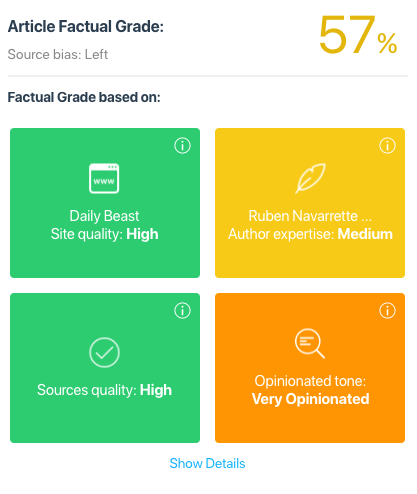‘The Factual’ is Changing the Way The World Consumes News
The consequences of fake news, how to combat it, and how to be more mindful about the content you consume online.

The consequences of fake news, how to combat it, and how to be more mindful about the content you consume online.
This past year, every one of us likely heard a story about Covid19 that turned out to be false.
Perhaps it was a promising treatment that you heard about from your cousin on Whatsapp or a rumor that Covid19 can spread through food that you saw in your newsfeed.
Given our heightened anxiety over Covid19, I know I took many of these stories seriously. Sometimes, I even argued with my family and friends when it turned out I had the facts wrong.
This was not only embarrassing but also dangerous from a health standpoint. I wanted to work on ways to be less susceptible to fake news.
Turns out the problem of fake news existed long before Covid19. From outright falsehoods like Pizzagate to the far more prevalent biased news that cast stories in a particular light, people’s trust in the news has been declining for years.
Now, even when we hear stories that are likely to be true, we may not believe them due to the perceived bias of the news source.
Why are we so bad at judging news credibility and what can we do to improve, especially as news grows exponentially every year?
This post discusses the implications of fake news and presents The Factual, an innovative solution that might deal with this issue at its root and eradicate it once and for all.
Key points (aka, the TL;DR version):
1. The Factual curates the most objective and informative stories across the political spectrum using a cool rating system.
2. Their daily newsletter and app are quick ways to be informed on critical topics, particularly in the US, World, and Business news.
3. Their ad-free format makes it easy to read and minimizes the time you spend on the news.
The impact of fake news
We’ve all had experiences where fake news on the internet has hampered our lives in some way. Whether it might be drawing us into heated arguments with friends or hampering relationships based on something we read online, the consequences of fake news are real.
Not just on a personal level, but the way fake news spreads can cause serious disruption to public life as well, as seen in the 2016 case at Washington D.C.
The World Economic Forum has compared the spread of fake news to “digital wildfires,” stating that unreliable information going viral online could be noted as one of the biggest threats faced by governments and societies today. The Center for Information Technology and Society at UC Santa Barbara notes that the targeted advertising of fake news can influence not just politics, but can also stir up and intensify social conflict.
Technology exploiting our cognitive bias?
The propagation of fake news can exploit the inherent cognitive bias every person holds. Elaborating on this,
- We prefer information from people and sources we trust.
- We pay attention to risks and are more likely to share information about potential risks with others.
- We remember things that fit well with what we already know and seek to amplify this knowledge by actively searching for more on the internet.
This can be made worse by modern technology.
As an article published in Scientific American puts it, “Search engines direct people to sites that inflame their suspicions, and social media connects them with like-minded people, feeding their fears. Making matters worse, bots — automated social media accounts that impersonate humans — enable misguided or malevolent actors to take advantage of their vulnerabilities. Compounding the problem is the proliferation of online information.”
What can we do to combat this problem?
This is the question a team of engineers from Stanford, IIT Madras, and Waterloo asked themselves when they were brainstorming ideas for a viable solution.
The result?
They built The Factual, a web-based service that helps you decide how credible a news source is, and sends a daily newsletter curating the most informative articles from across the political spectrum on the trending news topics.
The Factual has graded 10 million articles over the last three years and functions without human input. Thus, it offers a consistent assessment of news articles in just seconds and helps counter people’s biases. You can read more about how it works here.
I’ve been a subscriber to The Factual for about two weeks now and my experience has been amazing. Here are some reasons why I think this is such an innovative and life-changing service:
Credibility
I’m a firm believer in reading about the things going on around the world and keeping myself updated. But often, I’m too lazy to search for the context of the news or check how accurate it is.
The Factual makes this easier by grading each article something between 1% to 100% based on four metrics: the site quality, the author’s expertise, the quality and diversity of sources, and the tone of the writing. This ensures that all the news I read is credible and also helps me counter my own biases.

Helps counter information overload
The daily newsletter from The Factual curates the most important news items without having to actively search for what’s interesting. This saves time and keeps me from falling into an internet rabbit hole of too much information.
They also have a Chrome extension that helps me decide whether or not anything I read off their platform is credible.
A chance to form my own opinions
It’s natural to form opinions by reading news from a trusted source like The Guardian or The New York Times. But The Factual helps me counter this by giving me a chance to form my own opinions
A unique feature of The Factual newsletter is that each news item they provide is accompanied by three sources:
- Something that’s currently trending among all news websites.
- Another from a news source with a different political viewpoint.
- News from a local viewpoint.
This presents a balanced point of view, using which I can form my own opinions without being swayed by reading news from just one source.
A change in perspective
When something bad happens, most news channels tend to microfocus on the negativity and present to us the consequences in their worst possible form. This is where the human editors of The Factual newsletter come in.
Each newsletter comes with charts, pictures, and graphs that show the news in context, comparing it to other similar occurrences in different times and countries, showing the reader that even though it might seem like it, this isn’t the worst that could happen.
These pictures and snippets are hand-picked and curated to compare and understand the happenings around the world with reference to context.
A sense of community
When we get triggered by items we read on the news, it’s natural to want to rant, to talk about it with like-minded people. The Factual provides an opportunity to do just this by building a community of people passionate about current affairs and their impact on lives.
Their discussion panel is where you can rant and pour your heart out about how you feel. It’s anonymous, so you don’t have to worry about your name being associated with a particular political standpoint.
Even if you don’t actively participate in the discussion, reading comments from people with differing views helps you understand how things are on the other side of the line. This may make you more open-minded and ready to forgive a friend or relative with an opposing political stand to yours.
At the very least, reading a different point of view will help you understand how the human mind works and make you less likely to get triggered each time you hear something that contradicts your belief system.

A balanced viewpoint
The Factual website has a section called “Under-reported” that shows you topics that aren’t being talked about enough. This empowers you to pick your stand without being spoonfed by what the big media companies are sending your way.
Final words
No matter where you live and what your political standpoint is, it’s important to keep your cognitive biases in mind and be careful of how you let technology influence your thoughts and decisions.
The spread of fake news on the internet is a serious problem in today’s times, and companies like The Factual are doing a great job helping people decide for themselves what stand they are willing to take, rather than being forced to think in a particular direction by targeted ad campaigns.
The next time you read a news article online, take a few moments to think how credible it might be, and whether you’re seeing this article because you clicked on a few similar links before.
It’s easy to get misled in this digital world. But thanks to companies like The Factual, we at least have tools to help us navigate our way around fake news and its consequences.
If you’re someone who is mindful about the kind of news you consume and aren’t inclined to believe the first thing that you read, The Factual will make it easy for you. You should definitely go ahead and check it out.
Note: This post is a sponsored collaboration with The Factual. Even though The Factual is paying me to write about their platform, I resonated with the idea so much that I’d have written about them anyway.
I was so excited to share The Factual with the world, that I requested the founders if my audience can get some discount. They agreed! You can sign up here for an additional 10% off!
